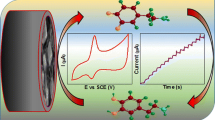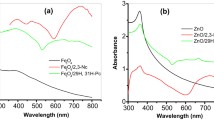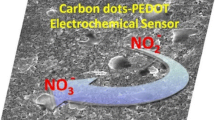Abstract
The redox polymer poly(methylene blue) was synthesized by electropolymerization in ethaline deep eutectic solvent (PMBDES), and employed in a new nanostructured composite together with carbon nanotubes (CNT). The polymer was formed either before or after CNT deposition on glassy carbon electrodes (GCE) to obtain GCE/PMBDES/CNT and GCE/CNT/PMBDES modified electrodes, respectively. The morphology of the hybrid films was investigated by scanning electron microscopy, and their electrochemical performance by cyclic voltammetry and electrochemical impedance spectroscopy. The composite with the highest faradaic response and electronic conductivity was identified and applied as a platform for the determination of ascorbic acid by fixed potential amperometry at +0.2 V vs. Ag/AgCl, and acetaminophen by square wave voltammetry and differential pulse voltammetry at +0.67 V vs. Ag/AgCl. The limits of detection of the best sensor configurations are 1.7 μM for AA, and 1.6 μM for APAP, and respective electrochemical sensitivities are 2.2 μA cm-2 μM−1 and 68.7 μA cm-2μM-1. The applicability of the electrochemical sensors was demonstrated by the successful quantification of both these key analytes in complex pharmaceutical formulations.

Poly(methylene blue) electrosynthesized in ethaline deep eutectic solvent (PMBDES) and employed in a nanostructured composite with CNT (PMBDES-CNT). PMBDES-CNT sensors characterized by SEM and electrochemical methods and applied to ascorbate (AA) and acetaminophen (APAP) electrochemical detection in pharmaceutical formulations.




Similar content being viewed by others
References
Barsan MM, Ghica ME, Brett CMA (2015) Electrochemical sensors and biosensors based on redox polymer/carbon nanotube modified electrodes: a review. Anal Chim Acta 881:1–23. doi:10.1016/j.aca.2015.02.059
Prathish KP, Carvalho RC, Brett CMA (2016) Electrochemical characterisation of poly(3,4-ethylenedioxythiophene) film modified glassy carbon electrodes prepared in deep eutectic solvents for simultaneous sensing of biomarkers. Electrochim Acta 187:704–713. doi:10.1016/j.electacta.2015.11.092
Wagle DV, Zhao H, Baker GA (2014) Deep eutectic solvents: sustainable media for nanoscale and functional materials. Acc Chem Res 47:2299–2308. doi:10.1021/ar5000488
Pauliukaite R, Ghica ME, Barsan MM, Brett CMA (2010) Phenazines and Polyphenazines in electrochemical sensors and biosensors. Anal Lett 43:1588–1608. doi:10.1080/00032711003653791
Kakhki S, Barsan MM, Shams E, Brett CMA (2013) New robust redox and conducting polymer modified electrodes for ascorbate sensing and glucose biosensing. Electroanalysis 25:77–84. doi:10.1002/elan.201200402
Kakhki S, Barsan MM, Shams E, Brett CMA (2013) New redox and conducting polymer modified electrodes for cholesterol biosensing. Anal Methods 5:1199–1204. doi:10.1039/c3ay26409b
Hosu O, Barsan MM, Cristea C et al (2017) Nanostructured electropolymerized poly(methylene blue) films from deep eutectic solvents. Optimization and characterization Electrochim Acta 232:285–295. doi:10.1016/j.electacta.2017.02.142
Chen Q, Espey MG, Krishna MC et al (2005) Pharmacologic ascorbic acid concentrations selectively kill cancer cells: action as a pro-drug to deliver hydrogen peroxide to tissues. Proc Natl Acad Sci U S A 102:13604–13609. doi:10.1073/pnas.0506390102
Cernat A, Tertiş M, Săndulescu R et al (2015) Electrochemical sensors based on carbon nanomaterials for acetaminophen detection: a review. Anal Chim Acta 886:16–28. doi:10.1016/j.aca.2015.05.044
Barsan MM, Toledo CT, Brett CMA (2015) New electrode architectures based on poly(methylene green) and functionalized carbon nanotubes: characterization and application to detection of acetaminophen and pyridoxine. J Electroanal Chem 736:8–15. doi:10.1016/j.jelechem.2014.10.026
Pifferi V, Barsan MM, Ghica ME et al (2013) Synthesis, characterization and influence of poly(brilliant green) on the performance of different electrode architectures based on carbon nanotubes and poly(3,4-ethylenedioxythiophene). Electrochim Acta 98:199–207. doi:10.1016/j.electacta.2013.03.048
Braik M, Barsan MM, Dridi C et al (2016) Highly sensitive amperometric enzyme biosensor for detection of superoxide based on conducting polymer/CNT modified electrodes and superoxide dismutase. Sensors Actuators B Chem 236:574–582. doi:10.1016/j.snb.2016.06.032
Barsan MM, Pifferi V, Falciola L, Brett CMA (2016) New CNT/poly(brilliant green) and CNT/poly(3,4-ethylenedioxythiophene) based electrochemical enzyme biosensors. Anal Chim Acta 927:35–45. doi:10.1016/j.aca.2016.04.049
Barsan MM, Prathish KP, Sun X, Brett CMA (2014) Nitrogen doped graphene and its derivatives as sensors and efficient direct electron transfer platform for enzyme biosensors. Sensors Actuators B Chem 203:579–587. doi:10.1016/j.snb.2014.07.019
Carvalho RC, Gouveia-Caridade C, Brett CMA (2010) Glassy carbon electrodes modified by multiwalled carbon nanotubes and poly(neutral red): a comparative study of different brands and application to electrocatalytic ascorbate determination. Anal Bioanal Chem 398:1675–1685. doi:10.1007/s00216-010-3966-3
Raoof JB, Ojani R, Baghayeri M et al (2011) A selective sensor based on a glassy carbon electrode modified with carbon nanotubes and ruthenium oxide/hexacyanoferrate film for simultaneous determination of ascorbic acid, epinephrine and uric acid. Anal Methods 3:2367–2373. doi:10.1039/c1ay05305a
Kul D, Ghica ME, Pauliukaite R, Brett CMA (2013) Talanta a novel amperometric sensor for ascorbic acid based on poly ( Nile blue a ) and functionalised multi-walled carbon nanotube modified electrodes. Talanta 111:76–84. doi:10.1016/j.talanta.2013.02.043
Cortez ML, Ceolin M, Azzaroni O, Battaglini F (2011) Electrochemical sensing platform based on polyelectrolyte-surfactant supramolecular assemblies incorporating carbon nanotubes. Anal Chem 83:8011–8018. doi:10.1021/ac202213t
Zhao D, Fan D, Wang J, Xu C (2015) Hierarchical nanoporous platinum-copper alloy for simultaneous electrochemical determination of ascorbic acid, dopamine, and uric acid. Microchim Acta 182:1345–1352. doi:10.1007/s00604-015-1450-7
Wang Q, Tang QL (2014) Improved sensing of dopamine and ascorbic acid using a glassy carbon electrode modified with electrochemically synthesized nickel-cobalt hexacyanoferrate microparticles deposited on graphene. Microchim Acta 182:671–677. doi:10.1007/s00604-014-1371-x
Taleb M, Ivanov R, Bereznev S et al (2017) Graphene-ceramic hybrid nanofibers for ultrasensitive electrochemical determination of ascorbic acid. Microchim Acta 184:897–905. doi:10.1007/s00604-017-2085-7
Wu F, Huang T, Hu Y et al (2016) Differential pulse voltammetric simultaneous determination of ascorbic acid, dopamine and uric acid on a glassy carbon electrode modified with electroreduced graphene oxide and imidazolium groups. Microchim Acta 183:2539–2546. doi:10.1007/s00604-016-1895-3
Brett CMA, Oliveira Brett AM (1998) Electroanalysis. Oxford University Press, New York
Li Y, Feng S, Li S et al (2014) A high effect polymer-free covalent layer by layer self-assemble carboxylated MWCNTs films modified GCE for the detection of paracetamol. Sensors Actuators B Chem 190:999–1005. doi:10.1016/j.snb.2013.09.052
Tertis M, Florea A, Sandulescu R, Cristea C (2013) Carbon based electrodes modified with horseradish peroxidase immobilized in conducting polymers for acetaminophen analysis. Sensors (Basel) 13:4841–4854. doi:10.3390/s130404841
Bayram E, Akyilmaz E (2016) Development of a new microbial biosensor based on conductive polymer/multiwalled carbon nanotube and its application to paracetamol determination. Sensors Actuators B Chem 233:409–418. doi:10.1016/j.snb.2016.04.029
Sonkar PK, Ganesan V, Prajapati A (2016) Polymeric co(salen) scaffold for the electrochemical determination of acetaminophen in pharmaceutical sample. Ionics (Kiel) 22:1741–1749. doi:10.1007/s11581-016-1699-9
Habibi B, Jahanbakhshi M, Pournaghi-Azar MH (2011) Simultaneous determination of acetaminophen and dopamine using SWCNT modified carbon-ceramic electrode by differential pulse voltammetry. Electrochim Acta 56:2888–2894. doi:10.1016/j.electacta.2010.12.079
Taei M, Jamshidi MS (2017) A voltammetric sensor for simultaneous determination of ascorbic acid, noradrenaline, acetaminophen and tryptophan. Microchem J 130:108–115. doi:10.1016/j.microc.2016.08.011
Tertiş M, Hosu O, Fritea L et al (2015) A novel label-free Immunosensor based on activated graphene oxide for acetaminophen detection. Electroanalysis 27:638–647. doi:10.1002/elan.201400583
Li J, Liu J, Tan G et al (2014) High-sensitivity paracetamol sensor based on Pd/graphene oxide nanocomposite as an enhanced electrochemical sensing platform. Biosens Bioelectron 54:468–475. doi:10.1016/j.bios.2013.11.001
Hosu O, Tertiş M, Săndulescu R, Cristea C (2015) Protein G magnetic beads based immunosensor for sensitive detection of acetaminophen. Farmacia 63:140–145
Acknowledgements
The authors are grateful for financial support from the Romanian National Authority for Scientific Research, CNCS - UEFISCDI, project number PNII-RU-TE-2014-4-0460 and from the Fundação para a Ciência e a Tecnologia (FCT), Portugal projects PTDC/QEQ-QAN/2201/2014, in the framework of Project 3599-PPCDT, and UID/EMS/00285/2013 (both co-financed by the European Community Fund FEDER), for financial support. O.H. thanks UMF for the internal grant number 7690/56/15.04.2016. M.M.B. thanks FCT for a postdoctoral fellowship SFRH/BPD/72656/2010.
Author information
Authors and Affiliations
Corresponding author
Ethics declarations
The author(s) declare that they have no competing interests.
Electronic supplementary material
ESM 1
(DOCX 487 kb)
Rights and permissions
About this article
Cite this article
Hosu, O., Barsan, M.M., Cristea, C. et al. Nanocomposites based on carbon nanotubes and redox-active polymers synthesized in a deep eutectic solvent as a new electrochemical sensing platform. Microchim Acta 184, 3919–3927 (2017). https://doi.org/10.1007/s00604-017-2420-z
Received:
Accepted:
Published:
Issue Date:
DOI: https://doi.org/10.1007/s00604-017-2420-z




